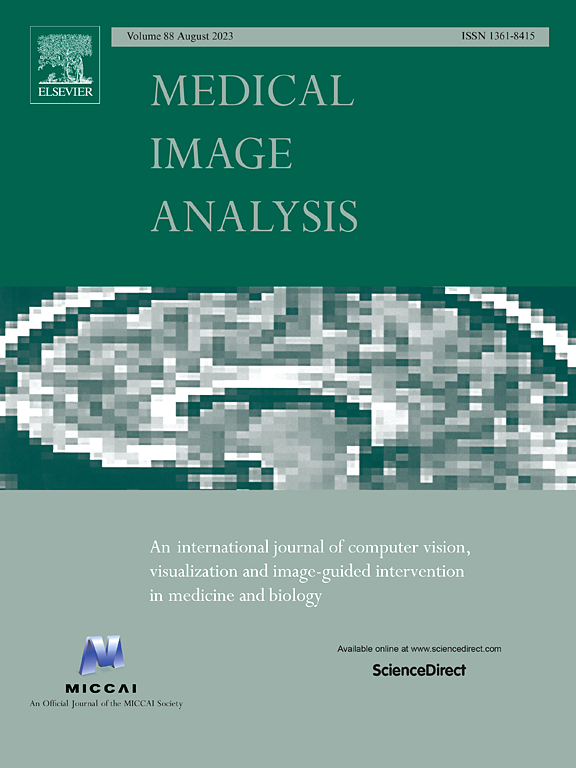CVFSNet: A Cross View Fusion Scoring Network for end-to-end mTICI scoring
IF 10.7
1区 医学
Q1 COMPUTER SCIENCE, ARTIFICIAL INTELLIGENCE
引用次数: 0
Abstract
The modified Thrombolysis In Cerebral Infarction (mTICI) score serves as one of the key clinical indicators to assess the success of the Mechanical Thrombectomy (MT), requiring physicians to inspect Digital Subtraction Angiography (DSA) images in both the coronal and sagittal views. However, assessing mTICI scores manually is time-consuming and has considerable observer variability. An automatic, objective, and end-to-end method for assigning mTICI scores may effectively avoid observer errors. Therefore, in this paper, we propose a novel Cross View Fusion Scoring Network (CVFSNet) for automatic, objective, and end-to-end mTICI scoring, which employs dual branches to simultaneously extract spatial–temporal features from coronal and sagittal views. Then, a novel Cross View Fusion Module (CVFM) is introduced to fuse the features from two views, which explores the positional characteristics of coronal and sagittal views to generate a pseudo-oblique sagittal feature and ultimately constructs more representative features to enhance the scoring performance. In addition, we provide AmTICIS, a newly collected and the first publicly available DSA image dataset with expert annotations for automatic mTICI scoring, which can effectively promote researchers to conduct studies of ischemic stroke based on DSA images and finally help patients get better medical treatment. Extensive experimentation results demonstrate the promising performance of our methods and the validity of the cross-view fusion module. Code and data will be available at https://github.com/xwjBupt/CVFSNet.
CVFSNet:用于端到端mTICI评分的交叉视图融合评分网络
改良的脑梗死溶栓(mTICI)评分是评估机械取栓(MT)成功的关键临床指标之一,要求医生检查冠状面和矢状面数字减影血管造影(DSA)图像。然而,手动评估mTICI分数是耗时的,并且具有相当大的观察者可变性。一种自动、客观、端到端分配mTICI分数的方法可以有效地避免观察者错误。因此,在本文中,我们提出了一种新的交叉视图融合评分网络(CVFSNet),用于自动、客观和端到端mTICI评分,该网络采用双分支同时从冠状和矢状视图中提取时空特征。然后,引入了一种新的交叉视图融合模块(CVFM)来融合两种视图的特征,该模块探索冠状和矢状视图的位置特征,生成伪斜矢状特征,最终构建更多具有代表性的特征来提高评分性能。此外,我们还提供了新采集的、首个公开的带有专家注释的DSA图像数据集AmTICIS,用于mTICI自动评分,可以有效地促进研究人员基于DSA图像开展缺血性脑卒中的研究,最终帮助患者获得更好的医疗。大量的实验结果证明了我们的方法的良好性能和交叉视图融合模块的有效性。代码和数据可在https://github.com/xwjBupt/CVFSNet上获得。
本文章由计算机程序翻译,如有差异,请以英文原文为准。
求助全文
约1分钟内获得全文
求助全文
来源期刊

Medical image analysis
工程技术-工程:生物医学
CiteScore
22.10
自引率
6.40%
发文量
309
审稿时长
6.6 months
期刊介绍:
Medical Image Analysis serves as a platform for sharing new research findings in the realm of medical and biological image analysis, with a focus on applications of computer vision, virtual reality, and robotics to biomedical imaging challenges. The journal prioritizes the publication of high-quality, original papers contributing to the fundamental science of processing, analyzing, and utilizing medical and biological images. It welcomes approaches utilizing biomedical image datasets across all spatial scales, from molecular/cellular imaging to tissue/organ imaging.
 求助内容:
求助内容: 应助结果提醒方式:
应助结果提醒方式:


